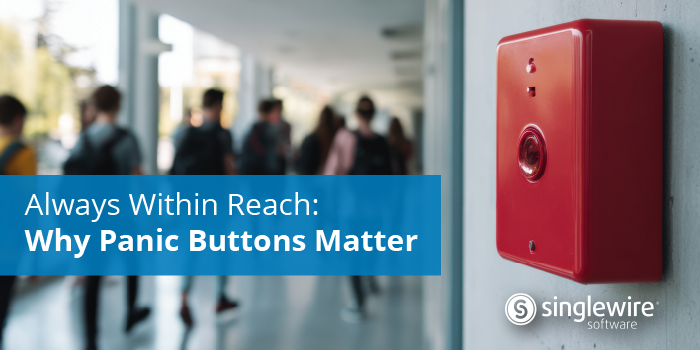Addressing Issues Big and Small
When schools consider implementing panic buttons, they often are thinking of worst-case scenarios. It’s natural to want to be able to alert the right people about critical incidents like active shooters, but focusing solely on major emergencies misses the bigger picture.
The reality is that every day school staff are requesting help for issues big and small that require a quick response. From fights in hallways to medical emergencies in classrooms to facility problems like burst pipes or gas leaks, incidents of all shapes and sizes disrupt the school day. Each one demands attention, and in every case, seconds matter.
That’s why panic buttons combined with robust critical communication software are essential tools for everyday school safety, not just rare emergencies.
Why Everyday Incidents Need Prompt Responses
When a student collapses from a medical condition, when two students get into a physical altercation, or when a teacher smells smoke, every moment spent waiting means more opportunity for the situation to escalate.
School staff often rely on radios, phones, or physically sending someone to get help. These methods introduce delays and rely heavily on availability, proximity, or clear communication under stress. When backed by the right critical communication software, panic buttons remove those barriers, giving staff a direct, discreet, and immediate way to request assistance from the front office, the facilities team, or even law enforcement.
Wearable Panic Buttons: Personalized Protection
One of the most effective options for schools today is wearable panic buttons. These lightweight, wireless devices can be clipped to an ID badge or worn on a lanyard, putting safety in every staff member’s hands.
Wearables offer several key advantages:
- Mobility: Teachers aren’t tied to a desk phone or classroom. They can request help from the playground, cafeteria, or hallway.
- Discretion: Wearables can be activated without drawing attention, reducing the chance of escalating a tense situation.
- Personalization: With the right software, alerts can carry information about who activated the button and where they are in the building, saving valuable response time.
By equipping staff with wearables, schools provide an added layer of protection that travels with them throughout the day.
Beyond Wearables: A Full Safety Ecosystem
While wearables offer personalized protection, they work best as part of a larger safety ecosystem. Not every staff member will wear a button all day, and different scenarios call for different solutions. That’s why modern safety platforms allow panic buttons to take multiple forms, including:
- Mounted Buttons: Installed under desks or on walls in classrooms, front offices, or cafeterias, offering an always accessible option in high-traffic or high-risk areas.
- Mobile Apps: Allow staff to trigger alerts directly from their smartphones, which are often within reach and enable them to request assistance outside of the immediate area of a school building, like a parking lot.
- Keyboard Shortcuts: Configured on desktop computers for quick activation during administrative work.
- IP Desk Phone Softkeys: Integrated into phones already on or near desks, offering one-touch emergency access.
When powered by the right software, all of these options can route alerts to the appropriate responders and broadcast updates via text, audio, and visual channels—speakers, desk phones, digital signage, desktop computers, and mobile devices.
The result? A layered safety net that ensures help is always accessible, no matter where or how an incident occurs.
Software as the Backbone of School Safety
It’s important to remember that hardware alone isn’t enough. A panic button is only effective if pressing it reliably delivers the right information to the right people at the right time. That’s where critical communication and incident management software comes in.
Robust software ensures that:
- Alerts are targeted: Notifications can be sent to specific groups—nurses for medical issues, administrators for fights, facilities teams for maintenance, law enforcement for major threats.
- Information is actionable: Alerts can include details like the identity of the staff member and their location within the building.
- Communication is multi-channel: Messages can reach staff through every connected endpoint, from mobile devices to overhead speakers, eliminating blind spots.
- Response is coordinated: Teams can manage follow-up actions, track incident resolution, and document events for compliance or audits.
With strong software backing every button press, schools can treat panic buttons not just as isolated devices, but as part of a comprehensive communication strategy.
The ROI of Everyday Use
Some school leaders worry that safety technology becomes a costly investment used only in rare, worst-case scenarios. Panic buttons, however, deliver everyday ROI because they support incidents that happen regularly—not just once in a rare while.
By giving staff an easy, reliable way to call for help with medical emergencies, behavior issues, or building problems, panic buttons:
- Reduce downtime: Issues are addressed faster, minimizing disruptions to learning.
- Improve confidence: Teachers and staff feel safer knowing help is always accessible.
- Streamline communication: Staff no longer waste time tracking down radios, phones, or administrators.
- Strengthen readiness: Regular use means staff are comfortable with the tools, so in the event of a large-scale emergency, they can respond faster and with less hesitation.
The more a system is used, the more value it delivers—and the better prepared schools are for anything that comes their way.
Building a Culture of Safety and Confidence
Panic buttons aren’t just about hardware or software. They’re about creating a culture where every staff member knows they’re supported, and where students see that adults are ready to act quickly in any situation.
By investing in panic buttons—wearable or otherwise—and pairing them with robust communication tools, schools show their commitment to safety and preparedness.
Emergencies don’t happen every day, but incidents do. And when those incidents happen, schools need tools that are always within reach.
Looking to strengthen safety and support your staff in every situation—from fights to fires? Explore our panic button page to see how solutions backed by powerful communication software can make sure help is always one touch away.
